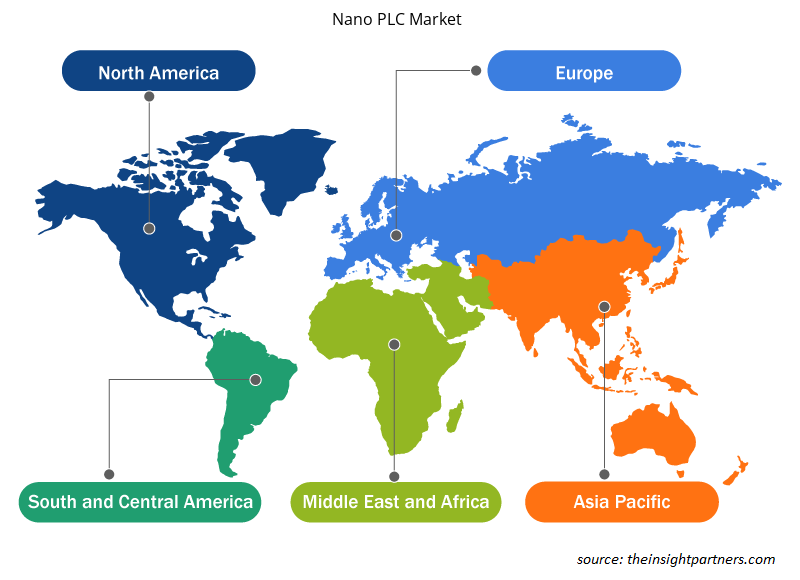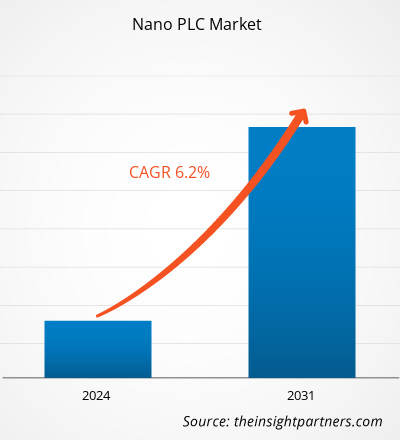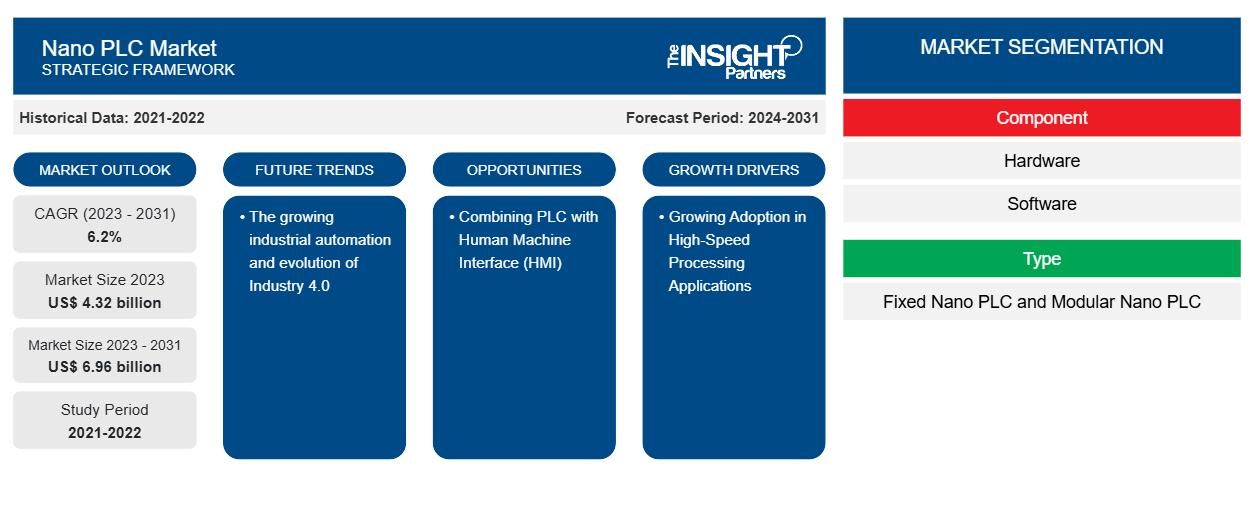Der Markt für Nano-SPS soll von 4,32 Milliarden US-Dollar im Jahr 2023 auf 6,96 Milliarden US-Dollar im Jahr 2031 anwachsen. Der Markt soll zwischen 2023 und 2031 eine durchschnittliche jährliche Wachstumsrate (CAGR) von 6,2 % verzeichnen. Die zunehmende industrielle Automatisierung und die Entwicklung von Industrie 4.0 werden voraussichtlich weiterhin wichtige Trends auf dem Markt für Nano-SPS bleiben.
Nano PLC Marktanalyse
Der Nano-SPS-Markt wächst rasant aufgrund der zunehmenden Verbreitung von Hochgeschwindigkeitsverarbeitungsanwendungen, der schnellen Industrialisierung und der zunehmenden Nutzung automatischer Sicherheitssysteme. Der Markt wächst stetig, angetrieben von der wachsenden Nachfrage nach intelligenter Fertigung. Darüber hinaus bieten die Kombination von SPS mit Mensch-Maschine-Schnittstellen (HMI) und die zunehmende Verbreitung technologisch fortschrittlicher Lösungen wie IoT-Beleuchtung lukrative Möglichkeiten für Marktwachstum.
Nano PLC Marktübersicht
Nano-SPS sind Steuergeräte, die industrielle Steuerungssysteme verbessern, indem sie die Anpassungsfähigkeit verbessern und die Komplexität verringern. Nano-SPS können industrielle Prozesse verbessern und optimieren, was ihre Akzeptanz in der Industrie erhöht. In den heutigen Industrieumgebungen entwickeln sich die Wettbewerbs- und Technologielandschaften rasant. Die Nachfrage nach großer industrieller Automatisierung hat die Akzeptanz von Nano-SPS zur Ausführung von Aufgaben durch Verbesserung der Produktivität und Kosteneinsparungen angekurbelt. Darüber hinaus beflügelt die wachsende Nachfrage nach flexiblen Automatisierungslösungen in der Industrie den Markt im Prognosezeitraum.
Passen Sie diesen Bericht Ihren Anforderungen an
Sie erhalten kostenlos individuelle Anpassungen an jedem Bericht, einschließlich Teilen dieses Berichts oder einer Analyse auf Länderebene, eines Excel-Datenpakets sowie tolle Angebote und Rabatte für Start-ups und Universitäten.
-
Holen Sie sich die wichtigsten Markttrends aus diesem Bericht.Dieses KOSTENLOSE Beispiel umfasst eine Datenanalyse von Markttrends bis hin zu Schätzungen und Prognosen.
Treiber und Chancen auf dem Nano-SPS-Markt
Zunehmende Nutzung von Hochgeschwindigkeitsverarbeitungsanwendungen treibt den Markt an
Nano-SPS sind sehr kompakte Lösungen mit Standardfunktionen, die einfach einzurichten sind. Die kompakte Größe von Nano-SPS erhöht ihre Akzeptanz bei Hochgeschwindigkeitsverarbeitungsanwendungen und Steuerungssystemen, die Zählkapazität oder kurze Reaktionszeiten erfordern. Nano-SPS sind in der Lage, mit verschiedenen Arten von kurzen Reaktionszeiten zu arbeiten, darunter schnelle Zähler (maximale Frequenz 10 kHz), schnelle Aufwärts-/Abwärtszähler (maximale Frequenz 1 kHz) und Frequenzmesser (maximale Frequenz 10 kHz). Darüber hinaus bieten Nano-SPS für Hochgeschwindigkeitsanwendungen erhebliche Vorteile wie die Verfügbarkeit von Batterie-Backups, PID-Schleifen für Steuerungssystemanwendungen , unbegrenzten schreibgeschützten Speicher und einen kostengünstigen Ersatz für herkömmliche Lösungen. Nano-SPS bietet jedoch Flexibilität durch einfache Steuerung und Handhabung komplexer Verarbeitungsanwendungen, was den Markt im Prognosezeitraum ankurbelt.
Kombination von SPS mit Mensch-Maschine-Schnittstelle (HMI) – eine Chance auf dem Nano-SPS-MarktPLC with Human Machine Interface (HMI) - An Opportunity in the Nano PLC Market
Die heutigen HMIs sind in der Lage, viele der Funktionen auszuführen, die früher von Steuerungssystemen ausgeführt und gehandhabt wurden, einschließlich der eigentlichen Maschinensteuerung und der E/A-Verarbeitung von Sensoren und Maschinen. Die Vermischung der Funktionen hat zur Entwicklung von HMI-SPS-Kombieinheiten geführt. Die Kombination ist eine natürliche Erweiterung eines anhaltenden Trends, da SPSen über eine Art Basisschnittstelle verfügen und HMIs sich zunehmend weiterentwickelt haben, um grundlegendere Steuerungsfunktionen bereitzustellen. Die Kombination von HMI-SPS-Einheiten vereint industriell gehärtete Geräte in einem einzigen Gehäuse. Diese Kombination fungiert als Webserver und bietet den Benutzern in der Regel erhebliche Vorteile beim Einstellen von Alarmen, Erstellen von Diagrammen, Aufzeichnen von Daten und Überwachen von Trends mit mehreren Steuerungsfunktionen, was ihre Akzeptanz in den Branchen erhöht. HMI-SPS-Einheiten unterstützen Branchen bei der Reduzierung der Betriebskomplexität und verkürzen die Entwicklungszeit durch Senkung der Gesamtbetriebskosten und werden im Prognosezeitraum voraussichtlich Marktchancen schaffen.
Segmentierungsanalyse des Nano PLC-Marktberichts
Wichtige Segmente, die zur Ableitung der Nano-SPS-Marktanalyse beigetragen haben, sind Komponente, Typ und Branche.
- Basierend auf den Komponenten ist der Nano-SPS-Markt in Hardware und Software unterteilt. Das Hardwaresegment ist weiter unterteilt in Prozessor, Stromversorgung, Eingabe/Ausgabe (I/O) und andere Hardware. Das Hardwaresegment hatte im Jahr 2023 einen größeren Marktanteil.
- Auf der Grundlage des Typs ist der Nano-SPS-Markt in feste Nano-SPS und modulare Nano-SPS unterteilt. Das Segment der festen Nano-SPS hatte im Jahr 2023 einen größeren Marktanteil.
- In Bezug auf die Branchen wird der Nano-SPS-Markt in die Branchen Automobil, Energie und Strom, Haus- und Gebäudeautomation, Öl und Gas, Pharmazeutika, Metalle und Bergbau sowie andere Branchen eingeteilt. Das Automobilsegment hatte im Jahr 2023 einen größeren Marktanteil.
Nano PLC Marktanteilsanalyse nach Geografie
Der geografische Umfang des Nano-SPS-Marktberichts ist hauptsächlich in fünf Regionen unterteilt: Nordamerika, Asien-Pazifik, Europa, Naher Osten und Afrika sowie Südamerika/Süd- und Mittelamerika.
In Bezug auf den Umsatz hatte der nordamerikanische Markt aufgrund der zunehmenden Automatisierung und der hohen Verbreitung technologisch fortschrittlicher Produkte den größten Marktanteil im Bereich Nano-SPS. Der zunehmende Fokus auf Forschungsaktivitäten zur Entwicklung hochwertiger Nano-SPS schafft Chancen auf dem Markt.
Der Markt im asiatisch-pazifischen Raum wird im Prognosezeitraum voraussichtlich wachsen, da zahlreiche Branchen wie Automobil, Energie und Strom, Öl und Gas und andere expandieren. Diese Branchen nutzen Nano-SPS zur Einführung intelligenter Fertigungsprozesse und treiben den Markt an. Darüber hinaus kurbeln zunehmende staatliche Initiativen zur Förderung von Automatisierungsprojekten und die wachsende Zahl von Infrastrukturentwicklungsaktivitäten den Markt im asiatisch-pazifischen Raum an.
Regionale Einblicke in den Nano-SPS-Markt
Die regionalen Trends und Faktoren, die den Nano-SPS-Markt im Prognosezeitraum beeinflussen, wurden von den Analysten von Insight Partners ausführlich erläutert. In diesem Abschnitt werden auch die Marktsegmente und die Geografie von Nano-SPS in Nordamerika, Europa, im asiatisch-pazifischen Raum, im Nahen Osten und Afrika sowie in Süd- und Mittelamerika erörtert.

- Holen Sie sich regionale Daten zum Nano-SPS-Markt
Umfang des Nano PLC-Marktberichts
| Berichtsattribut | Details |
|---|---|
| Marktgröße im Jahr 2023 | 4,32 Milliarden US-Dollar |
| Marktgröße bis 2031 | 6,96 Milliarden US-Dollar |
| Globale CAGR (2023 - 2031) | 6,2 % |
| Historische Daten | 2021-2022 |
| Prognosezeitraum | 2024–2031 |
| Abgedeckte Segmente |
Nach Komponente
|
| Abgedeckte Regionen und Länder |
Nordamerika
|
| Marktführer und wichtige Unternehmensprofile |
|
Marktteilnehmerdichte: Der Einfluss auf die Geschäftsdynamik
Der Markt für Nano-SPS wächst rasant, angetrieben durch die steigende Nachfrage der Endnutzer aufgrund von Faktoren wie sich entwickelnden Verbraucherpräferenzen, technologischen Fortschritten und einem größeren Bewusstsein für die Vorteile des Produkts. Mit steigender Nachfrage erweitern Unternehmen ihr Angebot, entwickeln Innovationen, um die Bedürfnisse der Verbraucher zu erfüllen, und nutzen neue Trends, was das Marktwachstum weiter ankurbelt.
Die Marktteilnehmerdichte bezieht sich auf die Verteilung von Firmen oder Unternehmen, die in einem bestimmten Markt oder einer bestimmten Branche tätig sind. Sie gibt an, wie viele Wettbewerber (Marktteilnehmer) in einem bestimmten Marktraum im Verhältnis zu seiner Größe oder seinem gesamten Marktwert präsent sind.
Die wichtigsten auf dem Nano-SPS-Markt tätigen Unternehmen sind:
- Crouzet Automatismes SAS
- Emerson Electric Co.
- EZAutomation
- Keyence Corporation
- Mitsubishi Electric Corporation
- OMRON Corporation
Haftungsausschluss : Die oben aufgeführten Unternehmen sind nicht in einer bestimmten Reihenfolge aufgeführt.

- Überblick über die wichtigsten Akteure auf dem Nano-SPS-Markt
Neuigkeiten und aktuelle Entwicklungen zum Nano-SPS-Markt
Der Nano-PLC-Markt wird durch die Erhebung qualitativer und quantitativer Daten nach Primär- und Sekundärforschung bewertet, die wichtige Unternehmensveröffentlichungen, Verbandsdaten und Datenbanken umfasst. Im Folgenden finden Sie eine Liste der Entwicklungen auf dem Markt für Nano-PLC und Strategien:
- Im April 2024 entschied sich das französische Unternehmen Crouzet für den Aerospace and Defence Park in Bangalore, um dort seine neue Fabrik zur Herstellung mechatronischer Komponenten für den indischen und internationalen Markt zu errichten. (Quelle: Französische Botschaft in Indien, Pressemitteilung, 2024)
Marktbericht zu Nano-SPS – Abdeckung und Ergebnisse
Der Bericht „Marktgröße und Prognose für Nano-SPS (2021–2031)“ bietet eine detaillierte Analyse des Marktes, die die folgenden Bereiche abdeckt:
- Marktgröße und Prognose auf globaler, regionaler und Länderebene für alle wichtigen Marktsegmente, die im Rahmen des Projekts abgedeckt sind
- Marktdynamik wie Treiber, Beschränkungen und wichtige Chancen
- Wichtige Zukunftstrends
- Detaillierte PEST/Porters Five Forces- und SWOT-Analyse
- Globale und regionale Marktanalyse mit wichtigen Markttrends, wichtigen Akteuren, Vorschriften und aktuellen Marktentwicklungen
- Branchenlandschaft und Wettbewerbsanalyse, einschließlich Marktkonzentration, Heatmap-Analyse, prominenten Akteuren und aktuellen Entwicklungen
- Detaillierte Firmenprofile
- Historische Analyse (2 Jahre), Basisjahr, Prognose (7 Jahre) mit CAGR
- PEST- und SWOT-Analyse
- Marktgröße Wert/Volumen – Global, Regional, Land
- Branchen- und Wettbewerbslandschaft
- Excel-Datensatz
Aktuelle Berichte
Erfahrungsberichte
Grund zum Kauf
- Fundierte Entscheidungsfindung
- Marktdynamik verstehen
- Wettbewerbsanalyse
- Kundeneinblicke
- Marktprognosen
- Risikominimierung
- Strategische Planung
- Investitionsbegründung
- Identifizierung neuer Märkte
- Verbesserung von Marketingstrategien
- Steigerung der Betriebseffizienz
- Anpassung an regulatorische Trends























 Kostenlose Probe anfordern für - Nano-SPS-Markt
Kostenlose Probe anfordern für - Nano-SPS-Markt